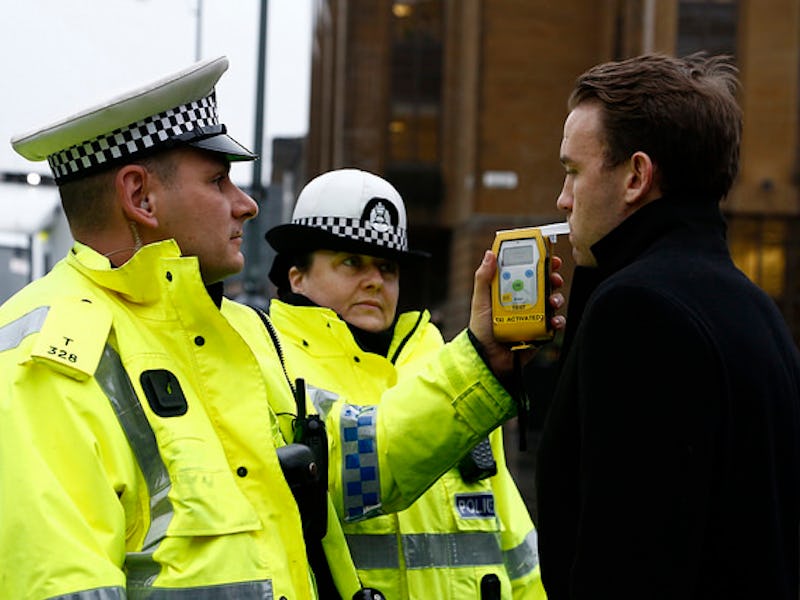Marijuana Breathalyzer Stumps Scientists, Thanks to Weed's Chemical Quirks
Researchers can't figure out how to chemically tell when people are high.

Marijuana legalization has accelerated at a breakneck pace in the United States over the past few years. And as this green wave rolls over the country, law enforcement and public health officials are struggling to keep up. Even if medical or recreational marijuana use is legal in your state or city, one simple fact remains: It’s still illegal to drive or operate machinery under the influence of marijuana. But how can officials test for it? This dilemma has driven a technological arms race, but it hasn’t yet yielded a reliable product, thanks to the unique nature of marijuana’s active ingredients.
Toxicologists have some ideas for a way forward, though. In a paper published Thursday in the journal Trends in Molecular Medicine, Marilyn Huestis, Ph.D., a 23-year veteran researcher of the National Institute on Drug Abuse, and Michael Smith, Ph.D., with whom Huestis runs a toxicology consulting company, outline what’s making it so hard to develop a roadside test for ∆9-tetrahydrocannabinol, the main active chemical in marijuana. They also offer an alternative to chemical testing.
THC can be detected in your urine for up to two months in some cases.
One of the major challenges involved with testing for THC, a fat-soluble drug, is that its pharmacokinetics — how the drug moves in and out of your body — are way different from water-soluble drugs like alcohol and cocaine. On the one hand, THC can actually be totally cleared from the bloodstream of an occasional smoker in under three hours, which means that if the cops pull you over and suspect intoxication, you’ll test negative by the time they get you to the station for a blood test. This makes a rapid test desirable for law enforcement.
On the other hand, chronic smokers could test positive pretty much any time. Since THC is fat-soluble, it gets absorbed and then slowly released over time by a person’s body tissues. For this reason, it’s very difficult to tell from a blood test whether a chronic smoker is stoned to the bone at that very second or whether it’s been two days since their last hit.
Therefore, the paper’s authors write, “a long terminal elimination phase makes it difficult to directly correlate blood concentrations and effects.” In other words, just because someone tests positive for THC doesn’t mean they’re under the immediate influence of the drug. This is one of the major challenges, the authors note, of trying to develop THC tests that are quick and reliable.
THC, marijuana's most well-known active chemical, can stay in your system for hours or weeks.
Since THC is such a slippery bugger, scientists often look for the metabolic byproducts of THC, including 11-nor-9-carboxy-▵ 9-tetrahydrocannabinol (THC-COOH). This chemical, which is produced when your body breaks down THC, is a very reliable marker of THC use. But the study’s authors say it’s very hard to measure it in a device like a breathalyzer.
Before we proceed further, it’s important to note that Huestis sits on the scientific advisory board for Cannabix, one of the companies racing to bring a marijuana breathalyzer device to market. This doesn’t mean her scientific opinion is any less valid, but it does mean that she has a dog in the marijuana breathalyzer fight.
That being said, Huestis and Smith argue that, given the challenging nature of rapid THC detection, law enforcement and substance abuse professionals should rely on their skills of perception to look for behavioral markers marijuana intoxication just as much as they depend on chemical testing.
Cannabix's marijuana breathalyzer prototype.
“It is clear that continued development of biological and behavioral cannabinoid markers is needed now and for the foreseeable future,” she and Smith conclude.
So far, 30 U.S. states have legalized medical marijuana, and eight states — as well as Washington, D.C. — have legalized recreational marijuana. The rapid pace of marijuana reform requires public health policy to match it. Huestis and Smith say in their paper that, due to THC’s highly variable pharmacokinetics, science does not yet support a legal limit for THC in drivers. But they also point out that law enforcement isn’t the only domain in which marijuana use is important to consider. It’s also important for substance abuse treatment and healthcare.
“Understanding the cannabis and synthetic cannabinoid intake history of an individual is vital for clinicians treating drug dependence, emergency department and primary care personnel, researchers investigating cannabinoid effects, medical examiners, and public health officials,” they write.
Despite the challenges facing rapid THC screening technology, there’s a lot of money to be made by selling the equipment to hospitals, law enforcement, and courts, so it’s unlikely that we’ve heard the last of the THC breathalyzer issue.
Abstract: Understanding cannabis and synthetic cannabinoid intake history is vital for treating drug dependence, investigating cannabinoid effects, and providing information to healthcare personnel, medical examiners, and public health officials; this is particularly relevant today with cannabis medicalization and legalization. Required information includes identifying exposure, time of use, frequency of use, relapse, withdrawal, and predicting cannabinoid effects. Recent controlled cannabinoid administration studies enable the development of models and markers to better identify patterns of intake and exposure. Future challenges include developing behavioral markers of cannabis impairment, bringing to market breathalyzers for cannabinoid detection, and identifying markers of recent cannabis intake under diverse biological matrices. We posit that biological monitoring of cannabinoids and metabolites will improve the characterization of cannabis and synthetic cannabinoid intake history.